
I am at my limit, sick to my stomach and reduced to guttural responses to my fear and fatigue. I have never climbed a mountain before, let alone one at 14,000 feet. On this late-season climb, I’ve seen my crampons spark on the rocks of the Disappointment Cleaver and twice tiptoed across ladders straddling yawning crevasses. And yet, the mountain expects more of me. I keep pushing as the rope propels me forward.
For the last two stretches of our Mt. Rainier ascent, Dominic, our guide and rope lead, coaches me to keep pace. He notices I’ve become sloppy maintaining the rope that connects me to my fellow climbers. I understand what is unsaid: if I don’t improve, I’ll have to descend the mountain without summiting.
At our final stop before the summit push, I feel the nearness of the mountain’s crater. And I feel far from the parking lot where our climb began 20 hours ago. But mostly, I feel exhausted. My inability to keep pace makes me feel like I am being pulled up the side of a mountain and, in fact, I am.
When Dominic tells me I won’t be continuing with the group, I accept his words with resignation and a small amount of relief.
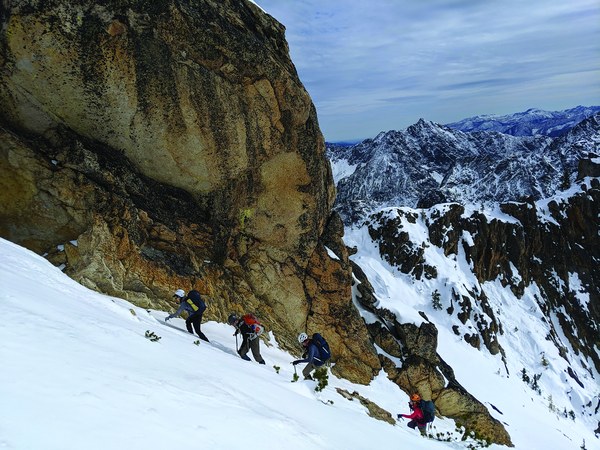 Alpine scramble at Wallaby Peak.
Alpine scramble at Wallaby Peak.
Checking boxes
This experience was not what I anticipated when I registered for a four-day summit climb with RMI Expeditions, the mountain guide company founded by Lou Whittaker. As a new Seattle resident, I was unpracticed in the ways of Pacific Northwest outdoor recreation. What I lacked in experience, I thought I made up for with an excellent record of achieving my goals.
Before Seattle, I lived in six cities around the world and never failed to embrace what made each place special. In Cambridge, Massachusetts, I ran along the Charles River after a day of classes. For the 18 months I lived in China, I navigated a new culture and language. During my studies in London, I took advantage of inexpensive flights to explore Europe. And my recent master’s degree in business administration instilled a heady confidence in my ability to conjure just about any accomplishment out of an expertly formatted spreadsheet.
Obviously, I identified summiting Mt. Rainier as a Washington rite of passage. Personally, this challenge met a deeper, more elemental need as well. I am restless and have been since I was a child. My goals are a means to manage this insistent anxiety, so I keep my list long and ambitious. If I check enough boxes of “must-do” experiences where I live, I can give myself permission – and perhaps justification – to leave someday.
Rerouting
In the weeks after my failed Rainier summit, I can still recognize the fear I felt on the upper mountain, but other, positive experiences shape my memories: the camaraderie of my climbing group, the beauty of seracs and snow, the clarity of mind I found focusing on each step. And so, I register for a Rainier six-day expedition climb with RMI in 2019, the following year. I want to try again.
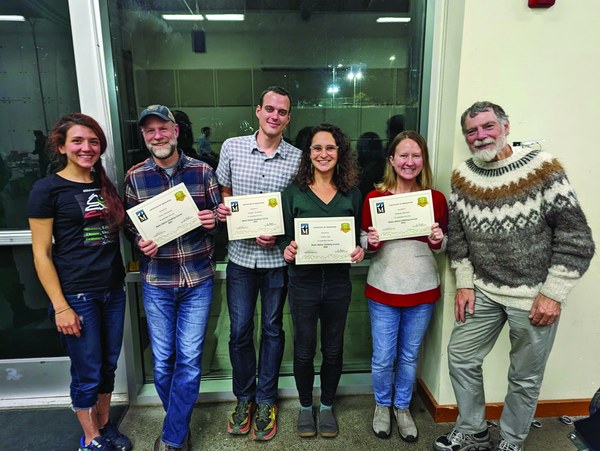 Seattle Basic Alpine Climbing climber's reunion.
Seattle Basic Alpine Climbing climber's reunion.
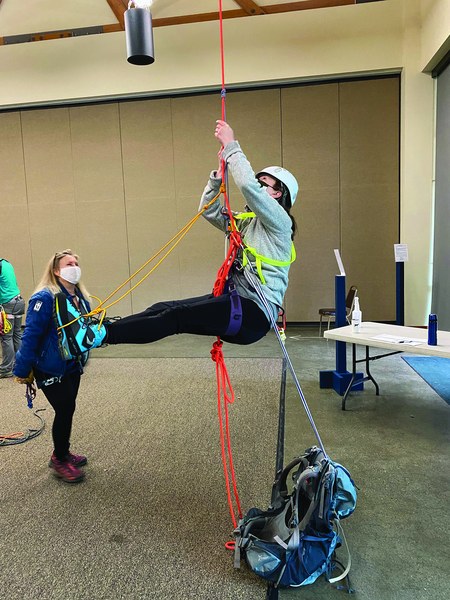 Basic Alpine Climbing course field trip demoing knots, ropes, and prusiking.
Basic Alpine Climbing course field trip demoing knots, ropes, and prusiking.
As part of my training plan, I enroll in many Mountaineers courses: Basic Scrambling, Backpacking Building Blocks (B3), Wilderness Navigation, and Wilderness First Aid. Having completed Basic Wilderness Skills in 2017 and the Conditioning Hiking Series in 2018, I know The Mountaineers system of awarding badges for completing courses suits me. I review my profile page of The Mountaineers website with satisfaction as my number of badges grows.
My training plan and Mountaineers activities distract me from a lonely period of life. My friends are marrying, buying houses, and becoming parents. I am not, mostly by choice. Rather than investigate my ambivalence, I narrow my scope to the objectives scheduled in my calendar and work through my feelings while running up my apartment stairs with a weighted backpack.
Back on Rainier
“If you continue past this break, then you’re going to the top,” Ben, our RMI guide tells me and the other climbers as we complete our break ritual — parka, pee, water, snack, sunscreen — as quickly as possible.
“How are you doing, Brittney? You going to do it this year?” Ross, another guide, asks me specifically.
I nod. I feel unexpectedly strong; far stronger than I was ten months ago when I was turned back at this very juncture. I’m still humbled by the mountain, but my fear is tempered by my physical and mental stamina.
Climbing resumes. The darkness we’ve been trudging through for hours recedes with the emerging sun, and my emotions give way. I let out sobs between pressure breaths as I realize I’m about to achieve a goal two years in the making. “I’m going to do it!” I repeat to myself, rest step after rest step, until we reach the flat, sulfurous crater of the mountain. I ask a fellow climber to take a video of me, and in it, I yell triumphantly, “I did it! The top of Mt. Rainier!”
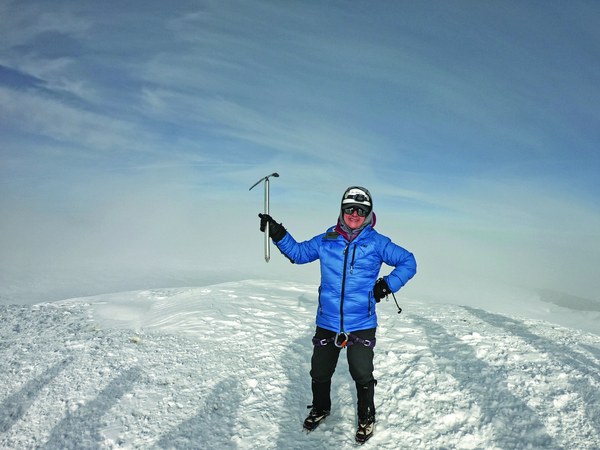 Brittney Moraski on the summit of Mt. Rainier.
Brittney Moraski on the summit of Mt. Rainier.
That summer, I am filled with awe again and again. On an August Mountaineers backpack circumnavigating Mt. St. Helens on the Loowit Trail, I become overwhelmed eating ripe, wild huckleberries. “A summer’s worth of photosynthesis!” I repeat with wonder, both to myself and to each perfectly delicious berry.
Reassessing
During the pandemic, I take to exploring my Capitol Hill neighborhood to interrupt the monotony of remote work. Sitting under the giant sequoias in Volunteer Park reminds me of backpacking, so I bring a blanket and spend an afternoon reading. Eventually, I stitch together an elaborate walking route that incorporates my favorite trees, three city parks, and a midway stop for a cookie and ice cream. It is – I tell myself – almost like hiking.
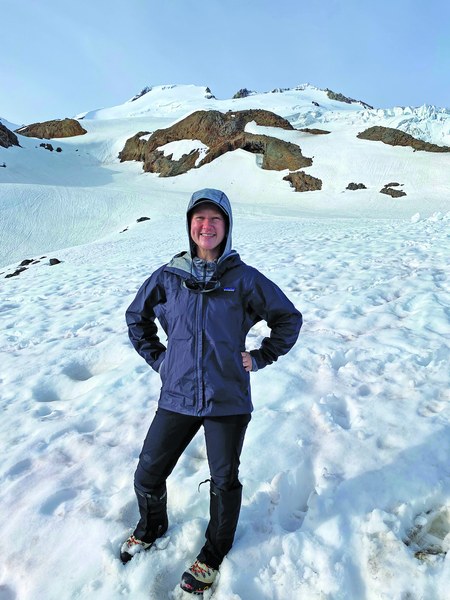 Basic glacier climb of Mt. Baker via the Easton Glacier route.
Basic glacier climb of Mt. Baker via the Easton Glacier route.
I am no longer tethered to Seattle for work. And, I have crossed the key items off on my PNW must-do list: summitting Mt. Rainier, completing STP (the Seattle-to-Portland bike ride), and even seeing the Dave Matthews Band perform at the Gorge. With this checklist complete, I start to imagine what my life could look like if I relocate again: maybe back to Washington, D.C., a place of happy memories, or to Chicago, a city that would bring me closer to family. I consider the appeal of each city, the lives I could live, and the new checklists I could pursue. And yet – and yet! – I find myself thinking how much there still is to explore in the Pacific Northwest.
Discovering the freedom of the hills
I complete the Basic Alpine Climbing course, a capstone of my Mountaineers education, in 2022. I join dating apps and add details from my adventures to my profile, including my Rainier summit video. One man asks if I want to climb the mountain again. He, too, is a mountaineer, and quickly becomes a constant in my life, steadying the freneticism of my untethered life.
I take pride in knowing that my outdoor abilities are something I acquired on my own, before my partner and I met. But his favorite activity is skiing, so our relationship becomes my opportunity to develop a new skill. In April 2023, I try backcountry skiing for the first time.
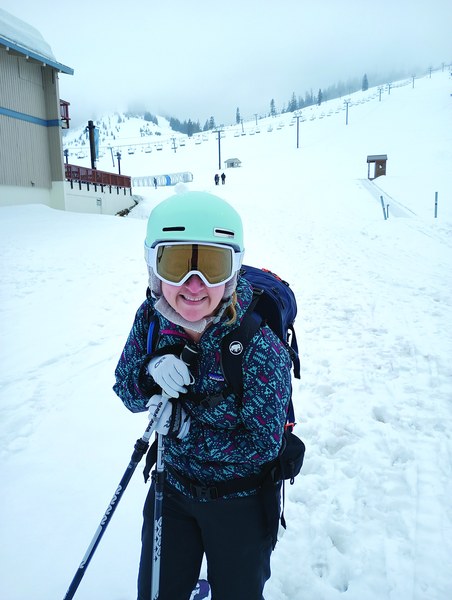 Skinning at Snoqualmie.
Skinning at Snoqualmie.
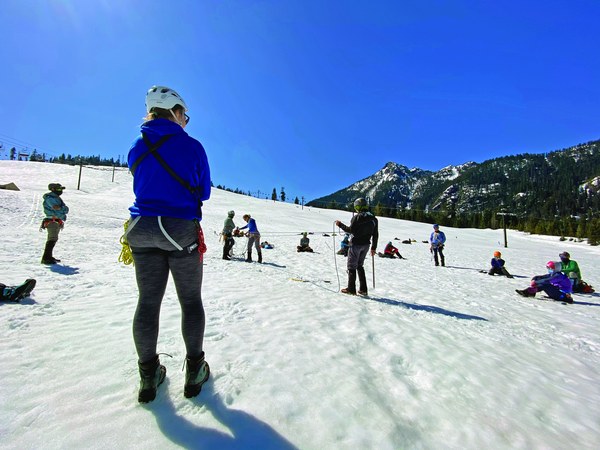 A snow field trip which included practice with ice axe arrest, roped travel, crevasse rescue, and snow camping.
A snow field trip which included practice with ice axe arrest, roped travel, crevasse rescue, and snow camping.
Summit at Snoqualmie is closed but there is enough snow to ski, if you’re willing to skin up, or to practice glacier travel, as I see others doing. As I grunt and maneuver up the slopes on my skis, a beginner once again, I watch the groups practicing rope management. I know who they must be – Mountaineers – and what they are doing, because I have been on that snow field trip before as a Mountaineers student.
Looking at this new cohort practicing snow travel at Snoqualmie, I feel a wave of warmth wash over me. I recognize that I am only able to repurpose my knowledge and conditioning to this new activity because hundreds of Mountaineers volunteers have shaped me into the strong and capable person I am today.
In addition to the nostalgia and gratitude, I feel something in me shift – something expanding to redefine how I think of myself, and even let go of what no longer serves me. I am witnessing others on a journey I have been on. A journey, I understand at last – not a checklist.
Arrival
For most of my life, I have equated adventure and exploration with picking up and moving, intentionally seeking novelty over community. I was driven to find something that could be tidily summarized, like reaching the summit of a mountain or achieving a course graduation badge. Now, the outdoors and The Mountaineers are leading me toward a slower, more mindful approach – toward savoring the miracle of ripe huckleberries, seeking comfort under the hardy branches of a sequoia, or discovering new ways to explore familiar landscapes.
I’m always going to be goal-oriented, but by slowing down and learning the necessary skills to safely travel in and explore the outdoors, I have come to appreciate things I would have otherwise missed: the land and its Indigenous history, watersheds, ecosystems, and what it means to honor, protect, and preserve. These aren’t boxes I can ever check; these are practices and beliefs I must commit to for my lifetime.
I now recognize what I misunderstood in my restlessness, something no badge or checklist can capture. The purpose of a journey isn’t to roam indefinitely, but to reach a destination, and then choose to stay.
This article originally appeared in our summer 2024 issue of Mountaineer magazine. To view the original article in magazine form and read more stories from our publication, visit our magazine archive.
 Brittney Moraski
Brittney Moraski